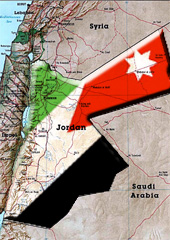Jordan’s Dry Times
Is Jordan’s scarce water supply going down the drain?
September 15, 2008

Every Saturday and Sunday a river flows down the hill past my house. It is a soapy, scummy stream of water coming from my neighbors washing their cars, doing laundry, watering potted plants and scrubbing sidewalks. This is because Saturday is water day in my neighborhood of Amman.
Under the country’s summer water rationing system, the city delivers water to each house once a week for a set amount of time. It is then up to the household to ration individual supply so as not to run out before the next water day.
The system is in place to help conserve the country’s scarce — and dwindling — water supply.
In fact, Jordan is among the top ten water-deprived countries in the world. Some even put it as the fourth-water-poorest nation.
The average Jordanian citizen — half of whom reside in the capital city, Amman — has access to less than 200 cubic meters of fresh water per year. This is in contrast to the average U.S. citizen, who has more than 9,000 cubic meters of water available each year — a 45-fold difference.
Although the Kingdom’s name comes from the Biblically important Jordan River, the country’s water scarcity is nothing new.
With the Dead Sea to the west and the Red Sea to the south — and land borders with Syria, Iraq, Saudi Arabia and Israel and the Palestinian territories — Jordan has no freshwater source, with the exception of groundwater aquifers.
Fresh water resources and water management in Jordan have been studied for decades.
And similarly for decades, aid agencies and government officials have been declaring impending doom for lack of potable water, and a permanent drought has been recognized.
There are 12 known groundwater aquifers in the country. However, according to the Jordan Ministry of Water and Irrigation, the long-term average of renewable available groundwater is approximately 275 cubic meters annually.
But still, water day is water consumption day. The hoses come out and squeegees are staffed by housewives and Egyptian or Filipina domestic helpers, ready to slosh the muck into the streets.
The Jordan Water Ministry has made efforts to reduce consumption by encouraging citizens to install low-flow faucets and half-flush toilets, to keep rinse time to a minimum when hand-washing dishes, and limit shower time.
Yet, for a country with such extensive water problems, there is a water park in Amman that bills itself as an “exciting tropical oasis dotted with all the means of comfort, fun and relaxation.”
Even more alarming, “half of Amman’s water supply is ‘lost’ or unaccounted for somewhere in the nation’s distribution network,” according to USAID.
Consumers in Jordan have attacked and injured water distributors and meter readers, demanding extra rations.
The country has been successful with establishing wastewater treatment plants to help offset the 70% of groundwater currently used for agricultural purposes.
But USAID reports that “two-thirds of the Kingdom’s water goes to low-value agricultural crops, while higher value demands for urban consumers, industry and tourism go unmet.”
Furthermore, low water prices and high demand — total demand is approaching one billion cubic meters per year — have made scarce water seem, in some cases, as if it were abundant.
The Jordan Water Ministry puts much of the blame for water scarcity and the high cost of improving the situation on the influx of refugees to the Kingdom.
Since 1948, Jordan has been host to Palestinian refugees, and some estimates put the Palestinian population in Jordan at more than 50%.
The Gulf War and current war in Iraq have added an additional 500,000 to 800,000 Iraqi refugees, according to the U.S. humanitarian organization Refugees International.
“The population increase of the country has not been normal, nor has the natural growth rate been sustainable,” the Jordan Water Ministry has said.
“Water scarcity is the most important natural constraint to Jordan’s economic development. Rapid increases in population and industrial development have placed unprecedented demands on water resources.”
Although water scarcity has been a source of conflict all over the world for eons, Jordan remains a politically stable and peaceful nation in a region rife with conflict.
But future stability and economic growth depend on Jordan’s ability to manage its water resources. It must account for the huge amount of “lost” or “missing” water, and it must do more to educate its people on the importance of water conservancy.
The need for water rationing should signify the seriousness of the situation. It should not be an excuse to wash the driveway and dump buckets of water down the drain.
Takeaways
Future stability and economic growth depend on Jordan's ability to manage its water resources.
The Jordan Water Ministry puts much of the blame for water scarcity on the influx of refugees to the Kingdom.
Half of Amman's water supply is lost or unaccounted for somewhere in the nation's distribution network.
Jordan is among the top ten water-deprived countries in the world.
For decades, aid agencies and government officials have been declaring impending doom for lack of potable water.
Read previous
Chinese Walls in Emerging Markets
September 12, 2008
